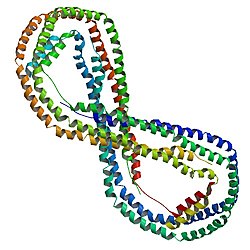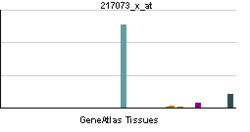载脂蛋白A1
载脂蛋白A1(英语:Apolipoprotein A1,简称ApoA1)为附着于高密度脂蛋白(HDL)及乳靡小球上的载脂蛋白,基因编码为“APOA1”[1][2]。载脂蛋白A1可以活化卵磷脂-胆固醇酰基转移酶(Lecithin Cholesterol Acyltransferase,LCAT);当高密度脂蛋白运送组织中多余的胆固醇回到肝脏细胞中时,载脂蛋白A1同时也可作为高密度脂蛋白的配体,在脂质代谢中扮演重要角色。研究指出,APOA1的mRNA是由反义RNA转译出的内源性蛋白质所调控[3]。
结构[编辑]
APOA1基因位于第11对染色体上(11q23-q24),该基因包含4个外显子[4]。载脂蛋白A1的质量为45.4 kDa ,含有 396 个氨基酸;质谱分析可观察到蛋白质由21个胜肽片段组成[5][6]。
功能[编辑]
载脂蛋白A1(ApoA1)为构成血浆中高密度脂蛋白(HDL)蛋白质部分的主要成分。小肠肠道细胞所分泌的乳糜微粒中虽然也含有载脂蛋白A1,但在血流中很快就会被转为HDL[7]。ApoA1可促进将周边组织脂质及胆固醇回收至肝脏,并借由胆管分泌至小肠。另外该蛋白也是卵磷脂-胆固醇酰基转移酶(LCAT)的辅因子,制造了血浆中大多数的胆固醇脂。ApoA1同时也是前列环素(PGI2)的稳定因子,因此也具有抗凝血的作用[8]。如果编码该蛋白的基因有缺陷,会导致个体体内缺乏HDL,导致包含Tangier disease在内的症状,以及非神经性全身类淀粉变性[4]。
由于ApoA1在体内脂质代谢的角色相当重要,因此常被视为预测个体冠心病风险的生物标记。有研究发现“apoB-100/apoA1”的比值预测心肌梗塞的效果比任何其他脂质标记更有效果[9]。ApoA1可利用ELISA或nephelometry检验。
临床意义[编辑]
Activity associated with high HDL-C and protection from heart disease[编辑]
As a major component of the high-density lipoprotein complex (protective "fat removal" particles), apo A1 helps to clear fats, including cholesterol, from white blood cells within artery walls, making the WBCs less likely to become fat overloaded, transform into foam cells, die and contribute to progressive atheroma. Five of nine men found to carry a mutation (E164X) who were at least 35 years of age had developed premature coronary artery disease.[10]One of four mutants of apo A1 is present in roughly 0.3% of the Japanese population, but is found in 6% of those with low HDL cholesterol levels.
ApoA-1 Milano is a naturally occurring mutant of apo A1, found in a few families in Limone sul Garda, Italy, and, by genetic + church record family tree detective work, traced to a single individual in the 14th century. Described in 1980, it was the first known molecular abnormality of apolipoproteins.[11]Paradoxically, carriers of this mutation have very low HDL-C (HDL-Cholesterol) levels, but no increase in the risk of heart disease, often living to age 100 or older. This unusual observation was what lead Italian investigators to track down what was going on and lead to the discovery of apo A1 Milano (the city, Milano, ~160 km away, in which the researcher's lab was located). Biochemically, apo A1 contains an extra cysteine bridge, causing it to exist as a homodimer or as a heterodimer with apo A-II. However, the enhanced cardioprotective activity of this mutant (which likely depends on fat & cholesterol efflux) cannot easily be replicated by other cysteine mutants.[12]
Recombinant apo A1 Milano dimers formulated into liposomes can reduce atheromas in animal models by up to 30%.[13]Apo A1 Milano has also been shown in small clinical trials to have a statistically significant effect in reducing (reversing) plaque build-up on arterial walls.[14][15]
In human trials the reversal of plaque build-up was measured over the course of five weeks.[14][16]
Novel Haplotypes within apolipoprotein AI-CIII-AIV gene cluster[编辑]
Lately, two novel susceptibility haplotypes i.e. P2-S2-X1 and P1-S2-X1 have been discovered in ApoAI-CIII-AIV gene cluster on chromosome 11q23, which confer approximately threefold higher risk of coronary heart disease in normal[17]as well as in the patients having non-insulin diabetes mellitus.[18]
Role in other diseases[编辑]
A G/A polymorphism in the promoter of the apo A1 gene has been associated with the age at which patients presented with Alzheimer disease.[19]Protection from Alzheimer's disease by apo A1 may rely on a synergistic interaction with alpha-tocopherol.[20] Amyloid deposited in the knee following surgery consists largely of apo A1 secreted from chondrocytes (cartilage cells).[21]A wide variety of amyloidosis symptoms are associated with rare Apo A1 mutants.
Apo A-I binds to lipopolysaccharide or endotoxin, and has a major role in the anti-endotoxin function of HDL.[22]
In one study, a decrease in apo A1 levels was detected in schizophrenia patients' CSF, brain and peripheral tissues.[23]
Epistatic impact of apo A1[编辑]
Apolipoprotein A1 and APOE interact epistatically to modulate triglyceride levels in coronary heart disease patients. Individually, neither apo A1 nor apo E was found to be associated with triglyceride (TG) levels, but pairwise epistasis (additive x additive model) explored their significant synergistic contributions with raised TG levels (P<0.01). [24]
Factors affecting apo A1 activity[编辑]
Apo A1 production is decreased by calcitriol, and increased by a drug that antagonizes it.[25]
Exercise or statin treatment may cause an increase in HDL-C levels by inducing apo A1 production, but this depends on the G/A promoter polymorphism.[26]
交互作用[编辑]
载脂蛋白A1可与下列蛋白产生交互作用:
Potential binding partners[编辑]
Apolipoprotein A1 binding precursor, a relative of APOA-1 abbreviated APOA1BP, has a predicted biochemical interaction with Carbohydrate Kinase Domain Containing Protein. The relationship between these two proteins is substantiated by cooccurance across genomes and coexpression.[30]The ortholog of CARKD in E. coli contains a domain not present in any eukaryotic ortholog. This domain has a high sequence identity to APOA1BP. CARKD is a protein of unknown function, and the biochemical basis for this interaction is unknown.
交互作用途径[编辑]
点击基因、蛋白质和代谢产物的链接访问对应的介绍条目。 [§ 1]
- ^ 这个相互作用途径可以在WikiPathways上编辑: Statin_Pathway_WP430.
参见[编辑]
参考文献[编辑]
- ^ Breslow JL, Ross D, McPherson J, Williams H, Kurnit D, Nussbaum AL, Karathanasis SK, Zannis VI. Isolation and characterization of cDNA clones for human apolipoprotein A-I. Proc. Natl. Acad. Sci. U.S.A. November 1982, 79 (22): 6861–5. PMC 347233
 . PMID 6294659. doi:10.1073/pnas.79.22.6861.
. PMID 6294659. doi:10.1073/pnas.79.22.6861.
- ^ Arinami T, Hirano T, Kobayashi K, Yamanouchi Y, Hamaguchi H. Assignment of the apolipoprotein A-I gene to 11q23 based on RFLP in a case with a partial deletion of chromosome 11, del(11)(q23.3----qter). Hum. Genet. June 1990, 85 (1): 39–40. PMID 1972696. doi:10.1007/BF00276323.
- ^ Halley P, Kadakkuzha BM, Faghihi MA, Magistri M, Zeier Z, Khorkova O, Coito C, Hsiao J, Lawrence M, Wahlestedt C. Regulation of the Apolipoprotein Gene Cluster by a Long Noncoding RNA. Cell Reports. 16 January 2014, 6 (1): 222–230. PMID 24388749. doi:10.1016/j.celrep.2013.12.015.
- ^ 4.0 4.1 Entrez Gene: APOA1 apolipoprotein A1. (原始内容存档于2019-10-16).
- ^ ]Zong NC, Li H, Li H, Lam MP, Jimenez RC, Kim CS, Deng N, Kim AK, Choi JH, Zelaya I, Liem D, Meyer D, Odeberg J, Fang C, Lu HJ, Xu T, Weiss J, Duan H, Uhlen M, Yates JR, Apweiler R, Ge J, Hermjakob H, Ping P. Integration of cardiac proteome biology and medicine by a specialized knowledgebase. Circulation Research. Oct 2013, 113 (9): 1043–53. PMC 4076475
 . PMID 23965338. doi:10.1161/CIRCRESAHA.113.301151.
. PMID 23965338. doi:10.1161/CIRCRESAHA.113.301151.
- ^ Apolipoprotein A-IV. Cardiac Organellar Protein Atlas Knowledgebase (COPaKB). [2016-08-13]. (原始内容存档于2016-03-05).
- ^ Wasan KM, Brocks DR, Lee SD, Sachs-Barrable K, Thornton SJ. Impact of lipoproteins on the biological activity and disposition of hydrophobic drugs: implications for drug discovery. Nature Reviews Drug Discovery. January 2008, 7 (1): 84–99. PMID 18079757. doi:10.1038/nrd2353.
- ^ Yui Y, Aoyama T, Morishita H, Takahashi M, Takatsu Y, Kawai C. Serum prostacyclin stabilizing factor is identical to apolipoprotein A1 (apo A1). A novel function of apo A1. J. Clin. Invest. 1988, 82 (3): 803–7. PMC 303586
 . PMID 3047170. doi:10.1172/JCI113682.
. PMID 3047170. doi:10.1172/JCI113682.
- ^ McQueen MJ, Hawken S, Wang X, Ounpuu S, Sniderman A, Probstfield J, Steyn K, Sanderson JE, Hasani M, Volkova E, Kazmi K, Yusuf S. Lipids, lipoproteins, and apolipoproteins as risk markers of myocardial infarction in 52 countries (the INTERHEART study): a case-control study. Lancet. 2008, 372 (9634): 224–33. PMID 18640459. doi:10.1016/S0140-6736(08)61076-4.
- ^ Dastani Z, Dangoisse C, Boucher B, Desbiens K, Krimbou L, Dufour R, Hegele RA, Pajukanta P, Engert JC, Genest J, Marcil M. A novel nonsense apolipoprotein A-I mutation (apoA-I(E136X)) causes low HDL cholesterol in French Canadians. Atherosclerosis. March 2006, 185 (1): 127–36. PMID 16023124. doi:10.1016/j.atherosclerosis.2005.05.028.
- ^ Franceschini G, Sirtori M, Gianfranceschi G, Sirtori CR. Relation between the HDL apoproteins and A-I isoproteins in subjects with the AIMilano abnormality. Metab. Clin. Exp. May 1981, 30 (5): 502–9. PMID 6785551. doi:10.1016/0026-0495(81)90188-8.
- ^ Zhu X, Wu G, Zeng W, Xue H, Chen B. Cysteine mutants of human apolipoprotein A-I: a study of secondary structural and functional properties. J. Lipid Res. 2005, 46 (6): 1303–11. PMID 15805548. doi:10.1194/jlr.M400401-JLR200.
- ^ Chiesa G, Sirtori CR. Apolipoprotein A-I(Milano): current perspectives. Curr. Opin. Lipidol. 2003, 14 (2): 159–63. PMID 12642784. doi:10.1097/00041433-200304000-00007.
- ^ 14.0 14.1 Apo A-I-Milano Trial: Where are we now?. Cleveland Clinic. [2008-07-26]. (原始内容存档于2007-12-21).
- ^ Nissen SE, Tsunoda T, Tuzcu EM, Schoenhagen P, Cooper CJ, Yasin M, Eaton GM, Lauer MA, Sheldon WS, Grines CL, Halpern S, Crowe T, Blankenship JC, Kerensky R. Effect of recombinant ApoA-I Milano on coronary atherosclerosis in patients with acute coronary syndromes: a randomized controlled trial. JAMA. November 2003, 290 (17): 2292–300. PMID 14600188. doi:10.1001/jama.290.17.2292.
- ^ Apo A-I Milano. Cedars-Sinai Heart Institute. [2008-07-26]. (原始内容存档于2007-12-21).
- ^ Singh P, Singh M, Kaur TP, Grewal SS. A novel haplotype in ApoAI-CIII-AIV gene region is detrimental to Northwest Indians with coronary heart disease. Int. J. Cardiol. September 2007, 130 (3): e93–5. PMID 17825930. doi:10.1016/j.ijcard.2007.07.029.
- ^ Singh P, Singh M, Gaur S, Kaur T. The ApoAI-CIII-AIV gene cluster and its relation to lipid levels in type 2 diabetes mellitus and coronary heart disease: determination of a novel susceptible haplotype. Diab Vasc Dis Res. June 2007, 4 (2): 124–9. PMID 17654446. doi:10.3132/dvdr.2007.030.
- ^ Vollbach H, Heun R, Morris CM, Edwardson JA, McKeith IG, Jessen F, Schulz A, Maier W, Kölsch H. APOA1 polymorphism influences risk for early-onset non-familial AD. Ann. Neurol. 2005, 58 (3): 436–41. PMID 16130094. doi:10.1002/ana.20593.
- ^ Maezawa I, Jin LW, Woltjer RL, Maeda N, Martin GM, Montine TJ, Montine KS. Apolipoprotein E isoforms and apolipoprotein A-I protect from amyloid precursor protein carboxy terminal fragment-associated cytotoxicity. J. Neurochem. 2004, 91 (6): 1312–21. PMID 15584908. doi:10.1111/j.1471-4159.2004.02818.x.
- ^ Solomon A, Murphy CL, Kestler D, Coriu D, Weiss DT, Makovitzky J, Westermark P. Amyloid contained in the knee joint meniscus is formed from apolipoprotein A-I. Arthritis Rheum. 2006, 54 (11): 3545–50. PMID 17075859. doi:10.1002/art.22201.
- ^ Ma J, Liao XL, Lou B, Wu MP. Role of apolipoprotein A-I in protecting against endotoxin toxicity. Acta Biochim. Biophys. Sin. (Shanghai). 2004, 36 (6): 419–24. PMID 15188057. doi:10.1093/abbs/36.6.419.
- ^ Huang JT, Wang L, Prabakaran S, Wengenroth M, Lockstone HE, Koethe D, Gerth CW, Gross S, Schreiber D, Lilley K, Wayland M, Oxley D, Leweke FM, Bahn S. Independent protein-profiling studies show a decrease in apolipoprotein A1 levels in schizophrenia CSF, brain and peripheral tissues. Mol Psychiatry. 2007, 13 (12): 1118–28. PMID 17938634. doi:10.1038/sj.mp.4002108.
- ^ Singh P, Singh M, Kaur T. Role of apolipoproteins E and A-I: Epistatic villains of triglyceride mediation in coronary heart disease. Int J Cardiol. 2008, 134 (3): 410–2. PMID 18378026. doi:10.1016/j.ijcard.2007.12.102.
- ^ Wehmeier K, Beers A, Haas MJ, Wong NC, Steinmeyer A, Zugel U, Mooradian AD. Inhibition of apolipoprotein AI gene expression by 1, 25-dihydroxyvitamin D3. Biochim. Biophys. Acta. 2005, 1737 (1): 16–26. PMID 16236546. doi:10.1016/j.bbalip.2005.09.004.
- ^ Lahoz C, Peña R, Mostaza JM, Jiménez J, Subirats E, Pintó X, Taboada M, López-Pastor A. Apo A-I promoter polymorphism influences basal HDL-cholesterol and its response to pravastatin therapy. Atherosclerosis. 2003, 168 (2): 289–95. PMID 12801612. doi:10.1016/S0021-9150(03)00094-7.
- ^ Fitzgerald ML, Morris AL, Rhee JS, Andersson LP, Mendez AJ, Freeman MW. Naturally occurring mutations in the largest extracellular loops of ABCA1 can disrupt its direct interaction with apolipoprotein A-I. J. Biol. Chem. September 2002, 277 (36): 33178–87. PMID 12084722. doi:10.1074/jbc.M204996200.
- ^ Deeg MA, Bierman EL, Cheung MC. GPI-specific phospholipase D associates with an apoA-I- and apoA-IV-containing complex. J. Lipid Res. March 2001, 42 (3): 442–51. PMID 11254757.
- ^ Pussinen PJ, Jauhiainen M, Metso J, Pyle LE, Marcel YL, Fidge NH, Ehnholm C. Binding of phospholipid transfer protein (PLTP) to apolipoproteins A-I and A-II: location of a PLTP binding domain in the amino terminal region of apoA-I. J. Lipid Res. January 1998, 39 (1): 152–61. PMID 9469594.
- ^ STRING: Known and Predicted Protein-Protein Interactions. (原始内容存档于2011-07-18).
外部链接[编辑]
| ||||||||||||||||||||||||||||||||||||||||||||||||||||||||||




